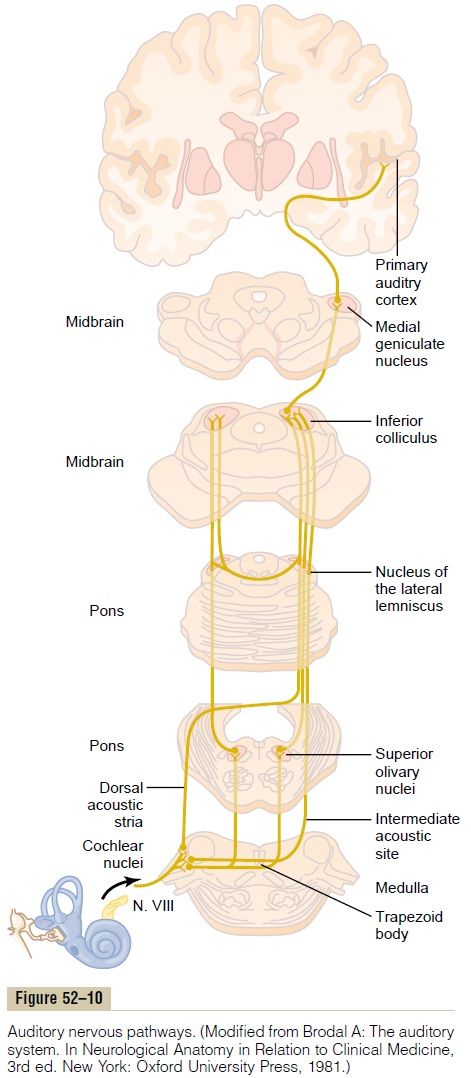Chapter: Medical Physiology: The Sense of Hearing
Auditory Nervous Pathways
Central Auditory Mechanisms
Auditory Nervous Pathways
Figure 52–10 shows the major auditory pathways. It shows that nerve fibers from the spiral ganglion of Corti enter the dorsal and ventral cochlear nuclei located in the upper part of the medulla. At this point, all the fibers synapse, and second-order neurons pass mainly to the opposite side of the brain stem to ter-minate in the superior olivary nucleus. A few second-order fibers also pass to the superior olivary nucleus on the same side. From the superior olivary nucleus, the auditory pathway passes upward through the lateral lemniscus. Some of the fibers terminate in the nucleus of the lateral lemniscus, but many bypass thisnucleus and travel on to the inferior colliculus, where all or almost all the auditory fibers synapse. From there, the pathway passes to the medial geniculatenucleus, where all the fibers do synapse. Finally, thepathway proceeds by way of the auditory radiation to the auditory cortex, located mainly in the superior gyrus of the temporal lobe.

Several important points should be noted. First, signals from both ears are transmitted through the pathways of both sides of the brain, with a prepon-derance of transmission in the contralateral pathway. In at least three places in the brain stem, crossing over occurs between the two pathways: (1) in the trapezoid body, (2) in the commissure between the two nuclei of the lateral lemnisci, and (3) in the commissure con-necting the two inferior colliculi.
Second, many collateral fibers from the auditory tracts pass directly into the reticular activating systemof the brain stem. This system projects diffuselyupward in the brain stem and downward into the spinal cord and activates the entire nervous system in response to loud sounds. Other collaterals go to the vermis of the cerebellum, which is also activated instan-taneously in the event of a sudden noise.
Third, a high degree of spatial orientation is main-tained in the fiber tracts from the cochlea all the way to the cortex. In fact, there are three spatial patterns for termination of the different sound frequencies in the cochlear nuclei, two patterns in the inferior colliculi, one precise pattern for discrete sound frequencies inthe auditory cortex, andat least five other less precisepatterns in the auditory cortex and auditory associa-tion areas.
Firing Rates at Different Levels of the Auditory Pathways. Singlenerve fibers entering the cochlear nuclei from the audi-tory nerve can fire at rates up to at least 1000 per second, the rate being determined mainly by the loud-ness of the sound. At sound frequencies up to 2000 to 4000 cycles per second, the auditory nerve impulses are often synchronized with the sound waves, but they do not necessarily occur with every wave.
In the auditory tracts of the brain stem, the firing is usually no longer synchronized with the sound fre-quency, except at sound frequencies below 200 cycles per second.Above the level of the inferior colliculi, even this synchronization is mainly lost. These findings demonstrate that the sound signals are not transmitted unchanged directly from the ear to the higher levels of the brain; instead, information from the sound signals begins to be dissected from the impulse traffic at levels as low as the cochlear nuclei. We will have more to say about this later, especially in relation to perception of direction from which sound comes.
Related Topics